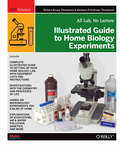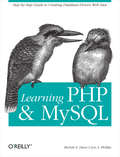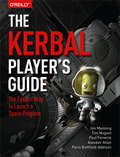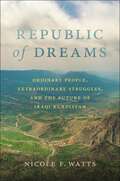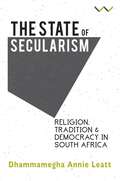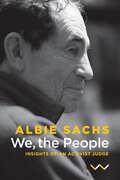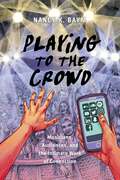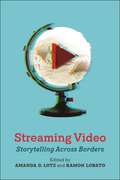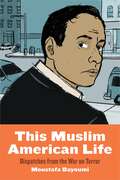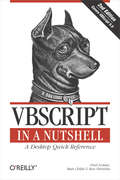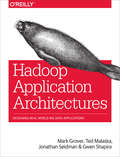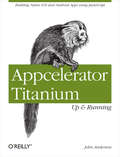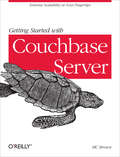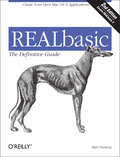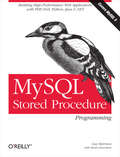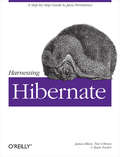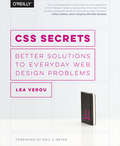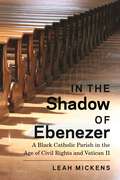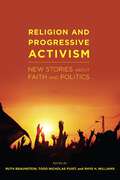- Table View
- List View
Illustrated Guide to Home Biology Experiments: All Lab, No Lecture
by Robert Bruce Thompson Barbara Fritchman ThompsonExperience the magic of biology in your own home lab. This hands-on introduction includes more than 30 educational (and fun) experiments that help you explore this fascinating field on your own. Perfect for middle- and high-school students and DIY enthusiasts, this full-color guide teaches you the basics of biology lab work and shows you how to set up a safe lab at home.The Illustrated Guide to Home Biology Experiments is also written with the needs of homeschoolers firmly in mind, as well as adults who are eager to explore the science of nature as a life-long hobby. To get the most from the experiments, we recommend using this guide in conjunction with a standard biology text, such as the freely downloadable CK-12 Biology (ck-12.org).Master the use of the microscope, including sectioning and stainingBuild and observe microcosms, soda-bottle worlds of pond lifeInvestigate the chemistry of life from simple acids, bases, and buffers to complex carbohydrates, proteins, lipids, enzymes, and DNAExtract, isolate, and observe DNAExplore photosynthesis, osmosis, nitrogen fixation, and other life processesInvestigate the cell cycle (mitosis and cytokinesis)Observe populations and ecosystems, and perform air and water pollution testsInvestigate genetics and inheritanceDo hands-on microbiology, from simple culturing to micro-evolution of bacteria by forced selectionGain hands-on lab experience to prepare for the AP Biology examThrough their company, The Home Scientist, LLC (thehomescientist.com/biology), the authors also offer inexpensive custom kits that provide specialized equipment and supplies you’ll need to complete the experiments. Add a microscope and some common household items and you’re good to go.
Learning PHP and MySQL
by Michele E. Davis Jon A. PhillipsThe PHP scripting language and MySQL open source database are quite effective independently, but together they make a simply unbeatable team. When working hand-in-hand, they serve as the standard for the rapid development of dynamic, database-driven websites. This combination is so popular, in fact, that it's attracting manyprogramming newbies who come from a web or graphic design background and whose first language is HTML. If you fall into this ever-expanding category, then this book is for you. Learning PHP and MySQL starts with the very basics of the PHP language, including strings and arrays, pattern matching and a detailed discussion of the variances in different PHP versions. Next, it explains how to work with MySQL, covering information on SQL data access for language and data fundamentals like tables and statements.Finally, after it's sure that you've mastered these separate concepts, the book shows you how to put them together to generate dynamic content. In the process, you'll also learn about error handling, security, HTTP authentication, and more. If you're a hobbyist who is intimidated by thick, complex computer books, then this guide definitely belongs on your shelf. Learning PHP and MySQL explains everything--from basic concepts to the nuts and bolts of performing specific tasks--in plain English. Part of O'Reilly's bestselling Learning series, the book is an easy-to-use resource designed specifically for newcomers. It's also a launching pad for future learning, providing you with a solid foundation for more advanced development.
Hadoop: Storage and Analysis at Internet Scale
by Tom WhiteGet ready to unlock the power of your data. With the fourth edition of this comprehensive guide, youâ??ll learn how to build and maintain reliable, scalable, distributed systems with Apache Hadoop. This book is ideal for programmers looking to analyze datasets of any size, and for administrators who want to set up and run Hadoop clusters.Using Hadoop 2 exclusively, author Tom White presents new chapters on YARN and several Hadoop-related projects such as Parquet, Flume, Crunch, and Spark. Youâ??ll learn about recent changes to Hadoop, and explore new case studies on Hadoopâ??s role in healthcare systems and genomics data processing.Learn fundamental components such as MapReduce, HDFS, and YARNExplore MapReduce in depth, including steps for developing applications with itSet up and maintain a Hadoop cluster running HDFS and MapReduce on YARNLearn two data formats: Avro for data serialization and Parquet for nested dataUse data ingestion tools such as Flume (for streaming data) and Sqoop (for bulk data transfer)Understand how high-level data processing tools like Pig, Hive, Crunch, and Spark work with HadoopLearn the HBase distributed database and the ZooKeeper distributed configuration service
The Kerbal Player's Guide: The Easiest Way to Launch a Space Program
by Alasdair Allan Paris Buttfield-Addison Tim Nugent Jon Manning Paul FenwickKerbal Space Program (KSP) is a critically acclaimed, bestselling space flight simulator game. It’s making waves everywhere from mainstream media to the actual space flight industry, but it has a bit of a learning curve. In this book, five KSP nerds—including an astrophysicist—teach you everything you need to know to get a nation of tiny green people into space.KSP is incredibly realistic. When running your space program, you’ll have to consider delta-V budgets, orbital mechanics, Hohmann transfers, and more. This book is perfect for video game players, simulation game players, Minecrafters, and amateur astronomers.Design, launch, and fly interplanetary rocketsCapture an asteroid and fly it into a parking orbitTravel to distant planets and plant a flagBuild a moon rover, and jump off a crater ridgeRescue a crew-mate trapped in deep space
Ajax on Java: The Essentials of XMLHttpRequest and XML Programming with Java
by Steven Douglas OlsonThis practical guide shows you how to make your Java web applications more responsive and dynamic by incorporating new Ajaxian features, including suggestion lists, drag-and-drop, and more. Java developers can choose between many different ways of incorporating Ajax, from building JavaScript into your applications "by hand" to using the new Google Web Toolkit (GWT). Ajax on Java starts with an introduction to Ajax, showing you how to write some basic applications that use client-side JavaScript to request information from a Java servlet and display it without doing a full page reload. It also presents several strategies for communicating between the client and the server, including sending raw data, and using XML or JSON (JavaScript Object Notation) for sending more complex collections of data. The book then branches out into different approaches for incorporating Ajax, which include: The Prototype and script.aculo.us Javascript libraries, the Dojo and Rico libraries, and DWRIntegrating Ajax into Java ServerPages (JSP) applicationsUsing Ajax with StrutsIntegrating Ajax into Java ServerFaces (JSF) applicationsUsing Google's GWT, which offers a pure Java approach to developing web applications: your client-side components are written in Java, and compiled into HTML and JavaScript Ajax gives web developers the ability to build applications that are more interactive, more dynamic, more exciting and enjoyable for your users. If you're a Java developer and haven't tried Ajax, but would like to get started, this book is essential. Your users will be grateful.
Republic of Dreams: Ordinary People, Extraordinary Struggles, and the Future of Iraqi Kurdistan
by Nicole F. WattsA harrowing political history of Kurdish Iraq told through the extraordinary rags-to-riches story of a childhood refugeeIn the Iran-Iraq war of the 1980s, Iraqi president Saddam Hussein used chemical weapons against his own people, the Iraqi Kurds. Five thousand people died in what became known as the Halabja Massacre, which has been deemed the worst chemical attack in history. Nicole F. Watts, a former journalist and now professor of political science, has spent over a decade researching the struggles of the Kurdish people in Iraq, and in vivid, lyrical prose, she tells their story through the eyes of Peshawa, a young Muslim Kurd whose family barely survived the bombing and then fled for their lives.Republic of Dreams is a harrowing portrait of Iraqi Kurdistan and its history, as it weathers Hussein’s genocidal campaign against the Kurds, a civil war, the US invasion of Iraq, the Arab Spring, and the sustained neglect of the city of Halabja. Throughout the book, the thread of Peshawa’s story immerses readers in the everyday and extraordinary world of Iraqi Kurds between the late 1980s and 2022, exploring the meaning of home and dislocation in the wake of war and genocide.Based on over a hundred in-depth interviews with Iraqi Kurdish activists, journalists, elected officials, and community organizers, and hundreds of hours of conversations with Peshawa and his family, Republic of Dreams brings to vivid life the story of modern Kurdistan, and the Kurdish national dream to have their own homeland.
The State of Secularism: Religion, Tradition and Democracy in South Africa
by Dhammamegha Annie LeattA history of global political secularism comparing religion and traditional authority in apartheid South Africa. The Dutch Reformed Church, it was said in apartheid South Africa, was the National Party at prayer, and indeed, given that the Bible was so fundamental to much of the legislation that governed the apartheid state, that apparently satirical description had the ring of truth. 'Religion in South Africa's past', writes Dhammamegha Annie Leatt has been 'saturated by politics' and politics 'saturated by religion'. So how, she asks, was it possible for a new state to found itself without religious authority? Why did the churches give up so much of their political role in the transition? How can we think about tradition and the customary in relation to secularism? How can we not? In The State of Secularism Leatt guides the reader from a history of global political secularism through an exploration of the roles played by religion and traditional authority in apartheid South Africa to the position of religion in the post-apartheid state. She analyses the negotiations relating to religion in the constitution-making process, arguing, that South Africa is both secular in its Constitution and judicial foundations and increasingly non-secular in its embrace of traditional authorities and customary law. In the final chapter Leatt turns her attention to post-apartheid South Africa, examining changing relationships between churches and the ruling African National Congress and the increasing influence of traditional leaders and evangelical Christians in an anti-liberal alliance. This book makes a tremendous contribution to the literature on postcolonial politics on the African continent. It has wonderful insights into the founding of a constitutional democracy in South African and will appeal to students in history, politics, sociology and anthropology and constitutional law.
We, the People: Insights of an activist judge
by Albie SachsA stirring collection of public talks and essays by an activist and former judge offers an intimate insider’s view of South Africa’s Constitution. This stirring collection of essays and talks by activist and former judge Albie Sachs is the culmination of more than 25 years of thought about constitution-making and non-racialism. Following the Constitutional Court's landmark Nkandla ruling in March 2016, it serves as a powerful reminder of the tenets of the Constitution, the rule of law and the continuous struggle to uphold democratic rights and freedoms. We, the People offers an intimate insider's view of South Africa's Constitution by a writer who has been deeply entrenched in its historical journey from the depths of apartheid right up to the politically contested present. As a second-year law student at the University of Cape Town, Sachs took part in the Defiance Campaign and went on to attend the Congress of the People in Kliptown, where the Freedom Charter was adopted in 1955. Three decades later, shortly after the bomb attack in Maputo that cost him his arm and the sight in one eye, he was called on by the Constitutional Committee of the African National Congress to co-draft (with Kader Asmal) the first outline of a Bill of Rights for a new democratic South Africa. In 1994, he was appointed by Nelson Mandela to the Constitutional Court, where he served as a judge until 2009. We, the People contains some of Sachs' most memorable public talks and writings, in which he takes us back to the broad-based popular foundations of the Constitution in the Freedom Charter. He picks up on Oliver Tambo's original vision of a non-racial future for South Africa, rather than one based on institutionalised power-sharing between the races. He explores the tension between perfectability and corruptibility, hope and mistrust, which lies at the centre of all constitutions. Sachs discusses the enforcement of social and economic rights, and contemplates the building of the Constitutional Court in the heart of the Old Fort Prison as a mechanism for reconciling the past and the future. Subjective experience and objective analysis interact powerfully in a personalised narrative that reasserts the value of constitutionality not just for South Africans, but for people striving to advance human dignity, equality and freedom across the world today.
Playing to the Crowd: Musicians, Audiences, and the Intimate Work of Connection (Postmillennial Pop #14)
by Nancy K. BaymExplains what happened to music—for both artists and fans—when music went online. Playing to the Crowd explores and explains how the rise of digital communication platforms has transformed artist-fan relationships into something closer to friendship or family. Through in-depth interviews with musicians such as Billy Bragg and Richie Hawtin, as well as members of the Cure, UB40, and Throwing Muses, Baym reveals how new media has facilitated these connections through the active, and often required, participation of the artists and their devoted, digital fan base.Before the rise of social sharing and user-generated content, fans were mostly seen as an undifferentiated and unidentifiable mass, often mediated through record labels and the press. However, in today’s networked era, musicians and fans have built more active relationships through social media, fan sites, and artist sites, giving fans a new sense of intimacy and offering artists unparalleled information about their audiences. However, this comes at a price. For audiences, meeting their heroes can kill the mystique. And for artists, maintaining active relationships with so many people can be both personally and financially draining, as well as extremely labor intensive.Drawing on her own rich history as an active and deeply connected music fan, Baym offers an entirely new approach to media culture, arguing that the work musicians put in to create and maintain these intimate relationships reflect the demands of the gig economy, one which requires resources and strategies that we must all come to recognize and appreciate.
Streaming Video: Storytelling Across Borders (Critical Cultural Communication)
by Amanda D. Lotz and Ramon LobatoAn international team of experts explores how streaming services are disrupting traditional storytelling.The rise of streaming has dramatically transformed how audiences consume media. Over the last decade, subscription video-on-demand (SVOD) services, including Netflix, Prime Video, and Disney+, have begun commissioning and financing their own original movies and TV shows, changing the way and the rate at which content is produced across the globe, from Mexico City to Mumbai. Streaming Video maps this international production boom and what it means for producers, audiences, and storytellers. Through eighteen richly textured case studies, ranging from original Korean dramas on Netflix to BluTV’s experimental Turkish series, the book investigates how streaming services both disrupt and maintain storytelling traditions in specific national contexts. To what extent, and how, are streamers expanding norms of television and film storytelling in different parts of the world? Are streamers enabling the creation of content that would not otherwise exist? What are the implications for different viewers, in different countries, with different tastes? Together, the chapters critically assess the impacts of streaming on twenty-first century audiovisual storytelling and rethink established understandings of transnational screen flows.
This Muslim American Life: Dispatches from the War on Terror
by Moustafa BayoumiWinner of the 2016 Evelyn Shakir Non-Fiction Arab American Book AwardA collection of insightful and heartbreaking essays on Muslim-American life after 9/11Over the last few years, Moustafa Bayoumi has been an extra in Sex and the City 2 playing a generic Arab, a terrorist suspect (or at least his namesake “Mustafa Bayoumi” was) in a detective novel, the subject of a trumped-up controversy because a book he had written was seen by right-wing media as pushing an “anti-American, pro-Islam” agenda, and was asked by a U.S. citizenship officer to drop his middle name of Mohamed.Others have endured far worse fates. Sweeping arrests following the terrorist attacks of September 11, 2001 led to the incarceration and deportation of thousands of Arabs and Muslims, based almost solely on their national origin and immigration status. The NYPD, with help from the CIA, has aggressively spied on Muslims in the New York area as they go about their ordinary lives, from noting where they get their hair cut to eavesdropping on conversations in cafés. In This Muslim American Life, Moustafa Bayoumi reveals what the War on Terror looks like from the vantage point of Muslim Americans, highlighting the profound effect this surveillance has had on how they live their lives. To be a Muslim American today often means to exist in an absurd space between exotic and dangerous, victim and villain, simply because of the assumptions people carry about you. In gripping essays, Bayoumi exposes how contemporary politics, movies, novels, media experts and more have together produced a culture of fear and suspicion that not only willfully forgets the Muslim-American past, but also threatens all of our civil liberties in the present.
The Pornification of America: How Raunch Culture Is Ruining Our Society
by Bernadette BartonAn up-close look at how porn permeates our culture Pictures of half-naked girls and women can seem to litter almost every screen, billboard, and advertisement in America. Pole-dancing studios keep women fit. Men airdrop their dick pics to female passengers on planes and trains. To top it off, the last American President has bragged about grabbing women “by the pussy.”This pornification of our society is what Bernadette Barton calls “raunch culture.” Barton explores what raunch culture is, why it matters, and how it is ruining America. She exposes how internet porn drives trends in programming, advertising, and social media, and makes its way onto our phones, into our fashion choices, and into our sex lives. From twerking and breast implants, to fake nails and push-up bras, she explores just how much we encounter raunch culture on a daily basis—porn is the new normal.Drawing on interviews, television shows, movies, and social media, Barton argues that raunch culture matters not because it is sexy, but because it is sexist. She shows how young women are encouraged to be sexy like porn stars, and to be grateful for getting cat-called or receiving unsolicited dick pics. As politicians vote to restrict women’s access to birth control and abortion, The Pornification of America exposes the double standard we attach to women’s sexuality.
VBScript in a Nutshell: A Desktop Quick Reference
by Paul Lomax Ron Petrusha Matt ChildsLightweight yet powerful, VBScript from Microsoft® is used in four main areas: server-side web applications using Active Server Pages (ASP), client-side web scripts using Internet Explorer, code behind Outlook forms, and automating repetitive tasks using Windows Script Host (WSH). VBScript in a Nutshell, Second Edition delivers current and complete documentation for programmers and system administrators who want to develop effective scripts.Completely updated for VBScript 5.6, WSH 5.6 and ASP 3.0, VBScript In a Nutshell, Second Edition includes updated introductory chapters that will help you keep current with the significant changes since the first edition was published. New chapters introduce the Windows Script Component for creating binary COM components, and the Script Encoder.The main part of the book is a comprehensive reference focusing on VBScript essentials with an alphabetical reference to all statements, keywords and objects, and a section of notes and solutions to real-world gotchas--various undocumented behaviors and aspects of the language--to help you avoid potential problems. Each entry in the reference section details the following:The keyword's syntax, using standard code conventionsA list of arguments accepted by the function or procedure, if any existA discussion of how and where the keyword should be used within the scripting environmentA discussion of the differences between the operation of the keyword in Visual Basic or VBA and in VBScriptRegardless of your level of experience programming with VBScript, VBScript in a Nutshell, Second Edition is the book you'll want by your side--the most complete, up-to-date, and easy-to-use language reference available.
Head First Web Design: A Learner's Companion to Accessible, Usable, Engaging Websites (Head First)
by Jeff Siarto Ethan WatrallWant to know how to make your pages look beautiful, communicate your message effectively, guide visitors through your website with ease, and get everything approved by the accessibility and usability police at the same time? Head First Web Design is your ticket to mastering all of these complex topics, and understanding what's really going on in the world of web design.Whether you're building a personal blog or a corporate website, there's a lot more to web design than div's and CSS selectors, but what do you really need to know? With this book, you'll learn the secrets of designing effective, user-friendly sites, from customer requirements to hand-drawn storyboards all the way to finished HTML and CSS creations that offer an unforgettable online presence.The revised two-color edition of this book includes a free online version of the chapter on web color. You can easily access this chapter at Oreilly.com once you register your book.Your time is way too valuable to waste struggling with new concepts. Using the latest research in cognitive science and learning theory to craft a multi-sensory learning experience, Head First Web Design uses a visually rich format specifically designed to take advantage of the way your brain really works.
Hadoop Application Architectures: Designing Real-World Big Data Applications
by Ted Malaska Gwen Shapira Jonathan Seidman Mark GroverGet expert guidance on architecting end-to-end data management solutions with Apache Hadoop. While many sources explain how to use various components in the Hadoop ecosystem, this practical book takes you through architectural considerations necessary to tie those components together into a complete tailored application, based on your particular use case.To reinforce those lessons, the book’s second section provides detailed examples of architectures used in some of the most commonly found Hadoop applications. Whether you’re designing a new Hadoop application, or planning to integrate Hadoop into your existing data infrastructure, Hadoop Application Architectures will skillfully guide you through the process.This book covers:Factors to consider when using Hadoop to store and model dataBest practices for moving data in and out of the systemData processing frameworks, including MapReduce, Spark, and HiveCommon Hadoop processing patterns, such as removing duplicate records and using windowing analyticsGiraph, GraphX, and other tools for large graph processing on HadoopUsing workflow orchestration and scheduling tools such as Apache OozieNear-real-time stream processing with Apache Storm, Apache Spark Streaming, and Apache FlumeArchitecture examples for clickstream analysis, fraud detection, and data warehousing
Appcelerator Titanium: Building Native iOS and Android Apps Using JavaScript (Oreilly And Associate Ser.)
by John AndersonBuild native apps for iOS, Android, and Blackberry from a single JavaScript codebase with Appcelerator Titanium. This guide gets you quickly up to speed on this amazing framework and shows you how to generate cross-platform apps with 100% native controls. You’ll also learn the advantages of using Titanium when you want to create an app for just one native platform, rather than struggle with Java or Objective-C.Fast-paced and full of examples, this book helps you build your first project with Titanium Studio, and then takes you through the steps necessary to build complex data-bound apps.Learn how Titanium differs from frameworks such as jQuery Mobile and Sencha TouchSet up and use iOS and Android SDKs and compilers with TitaniumBuild basic UI and window controls, and create your own composite objectsTake a peek at how Titanium objects and methods work behind the scenesLearn how JavaScript makes Titanium easy to extend and customizeDevelop apps that consume complex data, whether it’s stored locally or on remote serversUnderstand the pros and cons of distributing apps on the App Store and Android Market
Getting Started with Couchbase Server: Extreme Scalability at Your Fingertips
by Mc BrownDo you know what to do if your web application goes viral and usage suddenly explodes? This concise guide introduces you to Couchbase Server, an extremely fast NoSQL database that automatically distributes data across a cluster of commodity servers or virtual machines. You’ll learn hands-on how to build a Couchbase cluster without changing your application, and how to expand your database on the fly without interrupting service.Discover how this open source server can help your application gain scalability and performance.Learn how the server’s architecture affects the way you build and deploy your databaseStore data without defining a data structure—and retrieve it without complex queries or query languagesUse a formula to estimate your cluster size requirementsSet up individual nodes through a browser, command line, or REST APIEnable your application to read and write data with sub-millisecond latency through managed object cachingGet a quick guide to building applications that integrate Couchbase’s core protocolIdentify problems in your cluster with the web consoleExpand or shrink your cluster, handle failovers, and back up data
REALBasic: The Definitive Guide, 2nd Edition
by Matt NeuburgREALbasic is a programming language in the best Macintosh tradition: visual, intuitive, and easy to learn. It allows you to create interfaces in minutes and entire, compiled applications without having to learn a complicated language; the strong object orientation makes it very easy even for beginners to develop, maintain, and alter projects. Best of all, an REALbasic 3, a single button click generates your project as a Mac OS 8/9 application, a Mac OS X native ("Carbon") application, or a Windows executable. No other application framework lets you compile for users on so many platforms so quickly and easily.REALbasic: The Definitive Guide not only gives you a firm grasp of the program's essential concepts, but also tells you things you won't learn from the official documentation alone. If you've never programmed before, the book offers both a primer in REALbasic and an intuitive approach to the concepts of programming itself, as you quickly reach the ability to program every aspect of REALbasic. You start out drawing the interface much as you would do in a drawing program: by selecting buttons, menus, dialog boxes, and the like from a tools menu. Then you use the code editor to fill in the code that tells these pieces what to do.The widely hailed first edition of REALbasic: The Definitive Guide has been completely rewritten to encompass reader suggestions and the many improvements of REALbasic 3--like its ability to compile and run under OS X.The book is divided into three sections:Fundamentals: a detailed summary of the language that quickly shows you how to think about programming and accomplish your goals in less timeUser Interface: how to create a complete application using the rich classes and pre-defined tools that make life so much easier for the REALbasic programmer.Reaching Out: Internet communications, databases, multimedia, game programming and more!
MySQL Stored Procedure Programming: Building High-Performance Web Applications in MySQL
by Steven Feuerstein Guy HarrisonThe implementation of stored procedures in MySQL 5.0 a hugemilestone -- one that is expected to lead to widespread enterprise adoption ofthe already extremely popular MySQL database. If you are serious aboutbuilding the web-based database applications of the future, you need toget up to speed quickly on how stored procedures work -- and how tobuild them the right way. This book, destined to be the bible of storedprocedure development, is a resource that no real MySQL programmer canafford to do without. In the decade since MySQL burst on the scene, it has become thedominant open source database, with capabilities and performancerivaling those of commercial RDBMS offerings like Oracle and SQLServer. Along with Linux and PHP, MySQL is at the heart of millions ofapplications. And now, with support for stored procedures, functions,and triggers in MySQL 5.0, MySQL offers the programming power neededfor true enterprise use. MySQL's new procedural language has a straightforward syntax, making iteasy to write simple programs. But it's not so easy to write secure,easily maintained, high-performance, and bug-free programs. Few in theMySQL world have substantial experience yet with stored procedures, butGuy Harrison and Steven Feuerstein have decades of combined expertise. In MySQL Stored Procedure Programming, they putthat hard-won experience to good use. Packed with code examples and coveringeverything from language basics to application building to advancedtuning and best practices, this highly readable book is the one-stopguide to MySQL development. It consists of four major sections:MySQL stored programming fundamentals -- tutorial, basicstatements, SQL in stored programs, and error handlingBuilding MySQL stored programs -- transaction handling,built-in functions, stored functions, and triggersMySQL stored programs in applications -- using storedprograms with PHP, Java, Perl, Python, and .NET (C# and VB.NET)Optimizing MySQL stored programs -- security, basic andadvanced SQL tuning, optimizing stored program code, and programmingbest practicesA companion web site contains many thousands of lines of code, that youcan put to use immediately.Guy Harrison is Chief Architect of Database Solutions at Quest Softwareand a frequent speaker and writer on MySQL topics. Steven Feuerstein isthe author of Oracle PL/SQL Programming, the classic reference for Oracle stored programming for more than ten years. Both have decades of experience as database developers, and between them they have authored a dozen books.
Harnessing Hibernate: Step-by-step Guide to Java Persistence
by James Elliott Timothy M. O'Brien Ryan FowlerHarnessing Hibernate is an ideal introduction to the popular framework that lets Java developers work with information from a relational database easily and efficiently. Databases are a very different world than Java objects, and they often involve people with different skills and specializations. With Hibernate, bridging these two worlds is significantly easier, and with this book, you can get up to speed with Hibernate quickly.Rather than present you with another reference, Harnessing Hibernate lets you explore the system, from download and configuration through a series of projects that demonstrate how to accomplish a variety of practical goals. The new edition of this concise guide walks you through Hibernate's primary features, which include mapping from Java classes to database tables, and from Java data types to SQL data types. You will also learn about Hibernate's data query and retrieval facilities, and much more.By reading and following along with the examples, you can get your own Hibernate environment set up quickly and start using it for real-world tasks right away. Harnessing Hibernate teaches you how to:Perform Object/Relational mappingWork with persistent data from Java codeWork with groups and relationships between objectsExtend Hibernate's rich type support for your own needsSimplify query creation using criteria and examplesUse the Hibernate Query Language (HQL) and understand how it differs from SQLUse Hibernate in conjunction with SpringUse Hibernate in conjunction with other packages, such as the Stripes web framework and the Eclipse IDEOnce you're past the first few chapters, you can jump to topics that you find particularly interesting or relevant. All background material and explanations of how Hibernate works and why is in the service of a focused task. Source code can be downloaded from the book's website.If using SQL is an uncomfortable chore, Harnessing Hibernate offers you an effective and trouble-free method for working with the information you store in your applications.
CSS Secrets: Better Solutions to Everyday Web Design Problems
by Lea VerouIn this practical guide, CSS expert Lea Verou provides 47 undocumented techniques and tips to help intermediate-to advanced CSS developers devise elegant solutions to a wide range of everyday web design problems.Rather than focus on design, CSS Secrets shows you how to solve problems with code. You'll learn how to apply Lea's analytical approach to practically every CSS problem you face to attain DRY, maintainable, flexible, lightweight, and standards-compliant results.Inspired by her popular talks at over 60 international web development conferences, Lea Verou provides a wealth of information for topics including:Backgrounds and BordersShapesVisual EffectsTypographyUser ExperienceStructure and LayoutTransitions and Animations
Cocoa in a Nutshell: A Desktop Quick Reference
by Michael Beam James Duncan DavidsonCocoa® is more than just a collection of classes, and is certainly more than a simple framework. Cocoa is a complete API set, class library, framework, and development environment for building applications and tools to run on Mac OS® X. With over 240 classes, Cocoa is divided into two essential frameworks: Foundation and Application Kit. Above all else, Cocoa is a toolkit for creating Mac OS X application interfaces, and it provides access to all of the standard Aqua® interface components such as menus, toolbars, windows, buttons, to name a few.Cocoa in a Nutshell begins with a complete overview of Cocoa's object classes. It provides developers who may be experienced with other application toolkits the grounding they'll need to start developing Cocoa applications. Common programming tasks are described, and many chapters focus on the larger patterns in the frameworks so developers can understand the larger relationships between the classes in Cocoa, which is essential to using the framework effectively.Cocoa in a Nutshell is divided into two parts, with the first part providing a series of overview chapters that describe specific features of the Cocoa frameworks. Information you'll find in Part I includes:An overview of the Objective-C languageCoverage of the Foundation and Application Kit frameworksOverviews of Cocoa's drawing and text handling classesNetwork services such as hosts, Rendezvous URL services, sockets, and file handlingDistributed notifications and distributed objects for interapplication communicationExtending Cocoa applications with other frameworks, including the AddressBook, DiscRecording, and Messaging frameworksThe second half of the book is a detailed quick reference to Cocoa's Foundation and Application Kit (AppKit) classes. A complement to Apple's documentation, Cocoa in a Nutshell is the only reference to the classes, functions, types, constants, protocols, and methods that make up Cocoa's Foundation and Application Kit frameworks, based on the Jaguar release (Mac OS X 10.2). Peer-reviewed and approved by Apple's engineers to be part of the Apple Developer Connection (ADC) Series, Cocoa in a Nutshell is the book developers will want close at hand as they work. It's the desktop quick reference they can keep by their side to look something up quickly without leaving their work.Cocoa in a Nutshell is the book developers will want close at hand as they work. It's the desktop quick reference they can keep by their side to look something up quickly without leaving their work.
In the Shadow of Ebenezer: A Black Catholic Parish in the Age of Civil Rights and Vatican II
by Leah MickensUncovers how the Civil Rights Movement and Vatican II affected African American Catholics in Atlanta The history and practices of African American Catholics has been vastly understudied, and Black Catholics are often written off as a fringe sector of the religious population. Yet, Catholics of African descent have been a part of Catholicism since the early days of European exploration into the New World.In the Shadow of Ebenezer examines how the Civil Rights Movement and the Second Vatican Council affected African American Catholics in Atlanta, Georgia, focusing on the historic Our Lady of Lourdes Catholic Church in the Old Fourth Ward. Our Lady of Lourdes is a neighbor of major historic Black Protestant churches in the city, including Ebenezer Baptist Church, a block away, which during the Civil Rights era was the pulpit of Martin Luther King Jr. Featuring archival and oral history sources, the book examines the religious and cultural life of the parishioners of Our Lady of Lourdes Catholic Church, showing how this Black Catholic congregation fit into the overall religious ecology of the neighborhood. Examining Our Lady of Lourdes in relation to these larger Black Protestant congregations helps to illuminate whether and how they were shaped by their place at a center of the civil rights struggle, and how religious change and social change intersect.
Land of Extraction: Property, Fracking, and Settler Colonialism
by Rebecca R. Scott2024 Outstanding Academic Title, given by Choice ReviewsExplores fracking’s dual impact on settler colonial culture and sustainabilityThrough meticulous research and poignant storytelling, Land of Extraction unravels the complex web of relationships between humans, places, and the environment, all bound by the concept of private property. It presents a thought-provoking analysis of how settler colonial culture imposes limits on environmental politics.Drawing on real-life events, fictional portrayals of fossil-fuel driven apocalypses, and firsthand ethnographic accounts of the fracking and pipeline boom in West Virginia, Rebecca R. Scott argues that the American dream’s promise of empowerment through property ownership actually restricts action against extractive industries and hampers the progress of environmental justice coalitions.As the ever-expanding reach of natural gas and pipeline industries takes its toll on communities, the book reveals the fractures in landowners’ reliance on private property, opening the door to more sustainable futures. A powerful call to reevaluate our perspectives and challenge the status quo, this book will leave readers questioning the foundations of our society and the possibilities that lie ahead.
Religion and Progressive Activism: New Stories About Faith and Politics (Religion and Social Transformation #6)
by Edited by Ruth Braunstein, Todd Nicholas Fuist, and Rhys H. WilliamsNew stories about religiously motivated progressive activism challenge common understandings of the American political landscape.To many mainstream-media saturated Americans, the terms “progressive” and “religious” may not seem to go hand-in-hand. As religion is usually tied to conservatism, an important way in which religion and politics intersect is being overlooked. Religion and Progressive Activism focuses on this significant intersection, revealing that progressive religious activists are a driving force in American public life, involved in almost every political issue or area of public concern. This volume brings together leading experts who dissect and analyze the inner worlds and public strategies of progressive religious activists from the local to the transnational level. It provides insight into documented trends, reviews overlooked case studies, and assesses the varied ways in which progressive religion forces us to deconstruct common political binaries such as right/left and progress/tradition. In a coherent and accessible way, this book engages and rethinks long accepted theories of religion, of social movements, and of the role of faith in democratic politics and civic life. Moreover, by challenging common perceptions of religiously motivated activism, it offers a more grounded and nuanced understanding of religion and the American political landscape.
